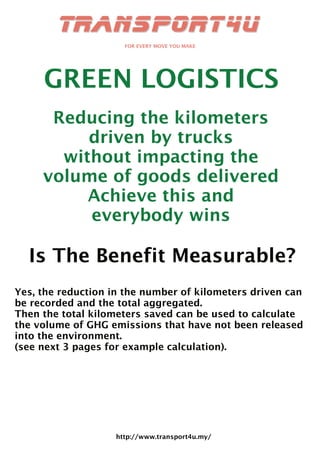
Calculating-volume-GHG-emissions-saved-from-reduction-in-kilometers-driven-by-lorries-in-Malaysia
- 1. http://www.transport4u.my/ GREEN LOGISTICS Reducing the kilometers driven by trucks without impacting the volume of goods delivered Achieve this and everybody wins Is The Benefit Measurable? Yes, the reduction in the number of kilometers driven can be recorded and the total aggregated. Then the total kilometers saved can be used to calculate the volume of GHG emissions that have not been released into the environment. (see next 3 pages for example calculation).
- 2. http://www.transport4u.my/ Green Logistics - Calculations How we will calculate the carbon footprint of truck transportation, numbers are for a Mid to Large truck at full load. For demonstration purposes the following assumptions have been made to determine the basis for this calculation. US EPA uses 6 miles/gallon as average basis for their truck emission calculations, so from this: US EPA = United States Environmental Protection Agency 1 gallon diesel = 3.78 liters 6 miles to a gallon therefore - 6 miles to 3.78 liters of diesel 1 mile = 1.6km therefore 6 miles x 1.6 = 9.6km 3.78liters diesel = 9.6km 37.8liters diesel = 96km We need to calculate how many liters of diesel will be used for 1 kilometer: 100/9.6=10.416 then 10.416x3.7=39.37 For simplicity we will round down to 39, so: 3.9liters diesel = 10km 39liters diesel = 100km 0.39liters diesel = 1km We Need To Calculate How Many KGs Of c02 are emitted during combustion: Next data (2.7kgc02) is taken from http://timeforchange.org/what-is-a- carbon-footprint-definition 2.7kgc02 is the volume of KG's of c02 emitted during combustion for 1 liter of diesel. for corroboration: this site calculates it at 2.63kgc02 http://www.sunearthtools.com/tools/CO2-emissions-calculator.php There are other online calculators that calculate KGs of c02 within a similar range of 2.63 to 2.7. For disclosure we are going with the upper figure of 2.7; pto....
- 3. http://www.transport4u.my/ 1. Our rationale behind using the 2.7 figure is the fleets of trucks operating in Malaysia use less green technology than their contemporary logistics company's in Europe and North America. 2. There is less driver training in Malaysia on how to operate a truck at its optimum environmentally friendly level. Next We Calculated How Many kgc02/km Diesel 1 liter = 2.7 kg c02 per unit 0.39liters diesel = 1km therefore 1km = 1.053kgc02/km This is how 1.053kgc02-km is calculated 2.7x39%= 1.053 so we rounded down to 1.05 Example Scenario For Clarity, Figures Below Consider Savings Made When Goods Are Placed Into Trucks That Would Have Been Travelling Anyway (goods in return truck with empty load). 10000 trucks at average saving of 500km each would be 5,000,000km saved in one month then - 5,265,000kg c02/km would be saved from Malaysia's carbon footprint. 5,000,000x1.053=5,265,000 5,265,000kg c02/km = 5265 metric tonnes Multiply by 12 months = 63180 metric tons reduction in one year The above, although close to being accurate is for illustration purposes, in real world scenario each category of truck will have an agreed upon standard calculation with the kilometers saved and the loading (weight) of truckload will have to be included to garner more precise information. The above example scenario is using figures to give an illustrative indication of what organised haulage matching services are capable of. pto.....
- 4. http://www.transport4u.my/ #note# in a the real world example the KM savings actually double up; For Example; If goods are put into an empty backload from Johor Bahru to KL then approximately 700km has been saved. This is because if no backload was found then a different truck would have to be booked in Johor which would then require a return journey from KL to Johor. Therefore one return load empty truck that has successfully gained a load for its journey will save a two way truck journey of the same route. There is serious potential to give major savings to Malaysia's overall carbon footprint by targeting goods into empty backloads. Added Data From WorldBank total c02 output in Malaysia in 2011 was 8,000,000 metric tons (for land transportation) 8 million being 18% of overall total of 43+ million metric tons (worldbank figures)